Related Research Articles

A sugar beet is a plant whose root contains a high concentration of sucrose and that is grown commercially for sugar production. In plant breeding, it is known as the Altissima cultivar group of the common beet. Together with other beet cultivars, such as beetroot and chard, it belongs to the subspecies Beta vulgaris subsp. vulgaris but classified as var. saccharifera . Its closest wild relative is the sea beet.

The silverleaf whitefly is one of several species of whitefly that are currently important agricultural pests. A review in 2011 concluded that the silverleaf whitefly is actually a species complex containing at least 40 morphologically indistinguishable species.

Potato leafroll virus (PLRV) is a member of the genus Polerovirus and family Solemoviridae. The phloem limited positive sense RNA virus infects potatoes and other members of the family Solanaceae. PLRV was first described by Quanjer et al. in 1916. PLRV is transmitted by aphids, primarily the green peach aphid, Myzus persicae. PLRV is one of the most important potato viruses worldwide but particularly devastating in countries with limited resources and management. It can be responsible for individual plant yield losses of over 50%. One estimate suggests that PLRV is responsible for an annual global yield loss of 20 million tons. Symptoms include chlorosis, necrosis and leaf curling.

Curly top is a viral disease that affects many crops. This disease causes plants to become smaller in size, have shriveled petals and leaves, and are twisted and pulled out of shape. They are often caused by curtoviruses, members of the virus family Geminiviridae. This disease is important in western United States, such as California, Utah, Washington, and Idaho.
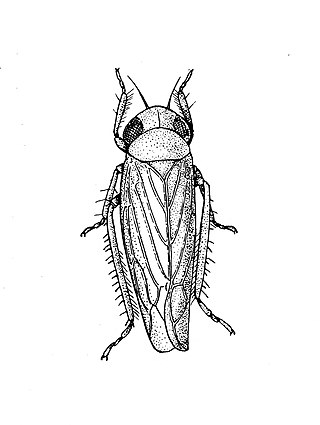
The beet leafhopper, also sometimes known as Neoaliturus tenellus, is a species of leafhopper which belongs to the family Cicadellidae in the order Hemiptera.

Cercospora beticola is a fungal plant pathogen which typically infects plants of the genus Beta, within the family of Chenopodiaceae. It is the cause of Cercospora leaf spot disease in sugar beets, spinach and swiss chard. Of these hosts, Cercospora leaf spot is the most economically impactful in sugar beets. Cercospora beticola is a deuteromycete fungus that reproduces using conidia. There is no teleomorph stage. C. beticola is a hemibiotrophic fungus that uses phytotoxins specifically Cercospora beticola toxin (CBT) to kill infected plants. CBT causes the leaf spot symptom and prevents root formation. Yield losses from Cercospora leaf spot are around 20 percent.

Heterodera schachtii, the beet cyst eelworm or sugarbeet nematode, is a plant pathogenic nematode. It infects more than 200 different plants including economically important crops such as sugar beets, cabbage, broccoli, and radish. H. schachtii is found worldwide. Affected plants are marked by stunted growth, wilting, yellowing, decreased yields, and death. While there are many methods of control, crop rotation with non-susceptible plants is preferred.

Cassava mosaic virus is the common name used to refer to any of eleven different species of plant pathogenic virus in the genus Begomovirus. African cassava mosaic virus (ACMV), East African cassava mosaic virus (EACMV), and South African cassava mosaic virus (SACMV) are distinct species of circular single-stranded DNA viruses which are transmitted by whiteflies and primarily infect cassava plants; these have thus far only been reported from Africa. Related species of viruses are found in India and neighbouring islands, though cassava is cultivated in Latin America as well as Southeast Asia. Nine species of cassava-infecting geminiviruses have been identified between Africa and India based on genomic sequencing and phylogenetic analysis. This number is likely to grow due to a high rate of natural transformation associated with CMV.
Arabis mosaic virus is a viral plant pathogen that is known to infect multiple hosts. The pathogen, commonly referred to as ArMV, is from the family Secoviridae, and it causes yellow dwarf of raspberry and is one of the causes of mosaic of rhubarb. Arabis mosaic virus infects multiple hosts, including strawberries, hops, hemp, grape, geraniums, raspberries, sugar beets, celery, horseradish, lilac, peach, and lettuces.

Beet curly top virus (BCTV) is a pathogenic plant virus of the family Geminiviridae, containing a single-stranded DNA. The family Geminiviridae consists of nine genera based on their host range, virus genome structure, and type of insect vector. BCTV is a Curtovirus affecting hundreds of plants. The only known vector is the beet leafhopper, which is native to the Western United States.
Beet necrotic yellow vein virus (BNYVV) is a plant virus, transmitted by the plasmodiophorid Polymyxa betae. The BNYVV is a member of the genus Benyvirus and is responsible for rhizomania, a disease of sugar beet that causes proliferation of thin rootlets, and leads to a smaller tap root with reduced sugar content. Infected plants are less able to take up water, and wilting can be observed during the warm period of the year. If the infection spreads to the whole plant, vein yellowing, necrosis and yellow spots appear on the leaves, giving the virus its name.
Tomato yellow leaf curl virus (TYLCV) is a DNA virus from the genus Begomovirus and the family Geminiviridae. TYLCV causes the most destructive disease of tomato, and it can be found in tropical and subtropical regions causing severe economic losses. This virus is transmitted by an insect vector from the family Aleyrodidae and order Hemiptera, the whitefly Bemisia tabaci, commonly known as the silverleaf whitefly or the sweet potato whitefly. The primary host for TYLCV is the tomato plant, and other plant hosts where TYLCV infection has been found include eggplants, potatoes, tobacco, beans, and peppers. Due to the rapid spread of TYLCV in the last few decades, there is an increased focus in research trying to understand and control this damaging pathogen. Some interesting findings include the virus being sexually transmitted from infected males to non-infected females, and an evidence that TYLCV is transovarially transmitted to offspring for two generations.
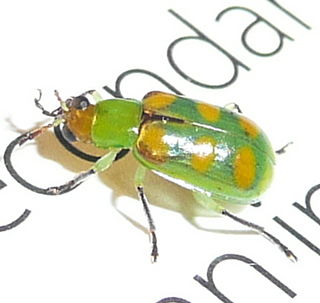
Diabrotica speciosa, also known as the cucurbit beetle and in Spanish as vaquita de San Antonio is an insect pest native to South America. Its larvae feed on the roots of crops. The cucurbit beetle is also known to transmit several viruses such as comoviruses and different mosaic viruses. This is native to South America and is now distributed in Central America and other global areas.

The black bean aphid is a small black insect in the genus Aphis, with a broad, soft body, a member of the order Hemiptera. Other common names include blackfly, bean aphid, and beet leaf aphid. In the warmer months of the year, it is found in large numbers on the undersides of leaves and on the growing tips of host plants, including various agricultural crops and many wild and ornamental plants. Both winged and wingless forms exist, and at this time of year, they are all females. They suck sap from stems and leaves and cause distortion of the shoots, stunted plants, reduced yield, and spoiled crops. This aphid also acts as a vector for viruses that cause plant disease, and the honeydew it secretes may encourage the growth of sooty mould. It breeds profusely by live birth, but its numbers are kept in check, especially in the later part of the summer, by various predatory and parasitic insects. Ants feed on the honeydew it produces, and take active steps to remove predators. It is a widely distributed pest of agricultural crops and can be controlled by chemical or biological means. In the autumn, winged forms move to different host plants, where both males and females are produced. These mate and the females lay eggs which overwinter.
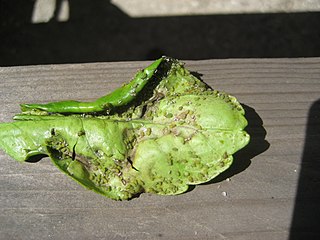
Trioza erytreae, the African citrus psyllid, is a sap-sucking insect, a hemipteran bug in the family Triozidae. It is an important pest of citrus, being one of only two known vectors of the serious citrus disease, huanglongbing or citrus greening disease. It is widely distributed in Africa. The other vector is the Asian citrus psyllid, Diaphorina citri.
Pemphigus betae, also known as the sugarbeet root aphid, is a species of gall-forming aphid that forms galls specifically on the commonly found narrowleaf cottonwood, Populus angustifolia. Sugarbeet root aphids have been found in North America and Europe. They infect sugarbeets, but also other plants like tablebeets and Swiss chard. Their size has been likened to that of a pinhead, and are pale white-yellow in color. Sugarbeet root aphids have soft bodies that are bulbous in shape, with mandibular parts that can pierce and suck and paired abdominal tubes that point backwards, and come in both winged and wingless forms. They are known for their consequential effects on agriculture due to infestation of plants, and efforts to control the pests have proved to be difficult.
The Citrus stubborn disease is a plant disease affecting species in the genus Citrus. The causative agent of the agent of the disease is Spiroplasma citri, a Mollicute bacterium species. The bacterium resides in the phloem of the affected plant. Originally discovered in citrus-growing regions of California, S. citri is transmitted by several leafhoppers, including Circulifer tenellus and Scaphytopius nitridus in citrus-growing regions of California. The disease has now spread to Arizona by the same hoppers, and Circulifer haematoceps in the Mediterranean region.
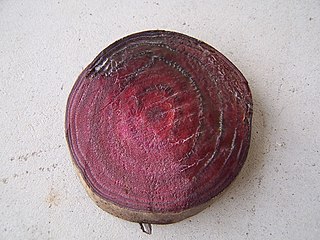
Beet vascular necrosis and rot is a soft rot disease caused by the bacterium Pectobacterium carotovorum subsp. betavasculorum, which has also been known as Pectobacterium betavasculorum and Erwinia carotovora subsp. betavasculorum. It was classified in the genus Erwinia until genetic evidence suggested that it belongs to its own group; however, the name Erwinia is still in use. As such, the disease is sometimes called Erwinia rot today. It is a very destructive disease that has been reported across the United States as well as in Egypt. Symptoms include wilting and black streaks on the leaves and petioles. It is usually not fatal to the plant, but in severe cases the beets will become hollowed and unmarketable. The bacteria is a generalist species which rots beets and other plants by secreting digestive enzymes that break down the cell wall and parenchyma tissues. The bacteria thrive in warm and wet conditions, but cannot survive long in fallow soil. However, it is able to persist for long periods of time in the rhizosphere of weeds and non-host crops. While it is difficult to eradicate, there are cultural practices that can be used to control the spread of the disease, such as avoiding injury to the plants and reducing or eliminating application of nitrogen fertilizer.
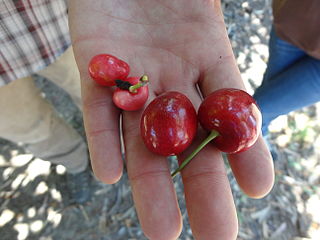
Cherry X disease also known as Cherry Buckskin disease is caused by a plant pathogenic phytoplasma. Phytoplasmas are obligate parasites of plants and insects. They are specialized bacteria, characterized by their lack of a cell wall, often transmitted through insects, and are responsible for large losses in crops, fruit trees, and ornamentals. The phytoplasma causing Cherry X disease has a fairly limited host range mostly of stone fruit trees. Hosts of the pathogen include sweet cherry, sour cherry, choke cherry, peaches, nectarines, almonds, clover, and dandelion. Most commonly the pathogen is introduced into economical fruit orchards from wild choke cherry and herbaceous weed hosts. The pathogen is vectored by mountain and cherry leafhoppers. The mountain leafhopper vectors the pathogen from wild hosts to cherry orchards but does not feed on the other hosts. The cherry leafhopper feeds on cherry trees and can transmit the disease from cherry orchards to peach, nectarine, and other economic crops. The Saddled Leafhopper is a vector of the disease in peaches. Control of Cherry X disease is limited to controlling the spread, vectors, and weed hosts of the pathogen. Once the pathogen has infected a tree it is fatal and removal is necessary to stop it from becoming a reservoir for vectors.
References
- ↑ Petherbridge, F.R.; Stirrup, H.H. (1935) Pests and diseases of the sugar beet. Bulletin of Ministry of Agriculture, Fisheries and Food No. 93.
- ↑ "EPPO" (PDF). Archived from the original (PDF) on 2010-07-13. Retrieved 2010-12-17.
- 1 2 Proeseler, G. (1983) Beet leaf curl virus. CMI/AAB Descriptions of Plant Viruses No. 268. Association of Applied Biologists, Wellesbourne, UK.
- ↑ Proeseler, G. (1966a) [Relationships between Piesma quadratum and beet leaf curl virus. I. Experiments of virus transmissibility and rearing of the vector]. Phytopathologische Zeitschrift 56, 191–211.
- ↑ Wille, J. (1928) [Beet leaf curl transmitted by the beet lace bug]. Arbeiten aus der Biologischen Reichsanstalt für Land- und Forstwirtschaft 16, 115–167.
- ↑ Hoffmann, G.H.; Schmutterer, H. (1983) Parasitäre Krankheiten und Schädlinge an landwirtschaftlichen Kulturpflanzen, 488 pp. Verlag Eugen Ulmer, Stuttgart, Germany.